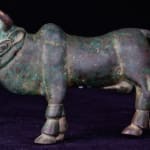Bronze Figure of a Bull, 600 BCE - 300 BCE
Bronze
4.26 x 3.5
LO.933
Further images
This bronze figure of a bull most likely had cultic connections, and was no doubt an object of worship in the cult of a deity with bovine associations. The range...
This bronze figure of a bull most likely had cultic connections, and was no doubt an object of worship in the cult of a deity with bovine associations. The range of time periods that this item may derive from lends it a number of possible connotations, from the Ptolemaic cult of Serapis to the Canaanite cult of El. Its limbs and its facial features are finely crafted, with an almost whimsical quality that belies its certainly sacred connotations. This image was a focus of reverence for those adherents who fashioned and employed this effigy.
The connotations to the bull are numerous in the ancient Mediterranean. The great temple at Memphis, Egypt, contained the enclosure of the Apis bull, regarded as the oracle “herald” of the god Ptah. The cult of Apis probably traces back to the Old Kingdom, and was later transformed in the Ptolemaic period into the cult of Serapis. Zeus was told to have transformed himself into a bull during his pursuit of Europa. In the Holy Land, the Canaanite ancestors of the Israelites drew a connection between the high god, El, and bulls, and it was in Old Testament times that graven images such as this one were forbidden to the Israelites, being reminiscent of the golden calf that the newly freed iIsraelites set up for worship during their time of doubt. All in all, in Classical Antiquity, the bull was a symbol of strength and fertility, and its connections with various pantheons and cultures were many. Regardless of what religious context this effigy derives from, it serves as a testament to the deep-set connection to bulls in the Mediterranean of Antiquity. This figure, whose exact derivation is still a mystery to us, most certainly carries with it the historical fingerprints of ancient peoples who looked upon it as a source of spiritual comfort and confidence amid the unpredictable world of early agrarian civilization.
The connotations to the bull are numerous in the ancient Mediterranean. The great temple at Memphis, Egypt, contained the enclosure of the Apis bull, regarded as the oracle “herald” of the god Ptah. The cult of Apis probably traces back to the Old Kingdom, and was later transformed in the Ptolemaic period into the cult of Serapis. Zeus was told to have transformed himself into a bull during his pursuit of Europa. In the Holy Land, the Canaanite ancestors of the Israelites drew a connection between the high god, El, and bulls, and it was in Old Testament times that graven images such as this one were forbidden to the Israelites, being reminiscent of the golden calf that the newly freed iIsraelites set up for worship during their time of doubt. All in all, in Classical Antiquity, the bull was a symbol of strength and fertility, and its connections with various pantheons and cultures were many. Regardless of what religious context this effigy derives from, it serves as a testament to the deep-set connection to bulls in the Mediterranean of Antiquity. This figure, whose exact derivation is still a mystery to us, most certainly carries with it the historical fingerprints of ancient peoples who looked upon it as a source of spiritual comfort and confidence amid the unpredictable world of early agrarian civilization.





